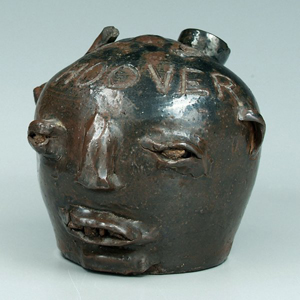
PHILADELPHIA (AP) – A folk art stoneware jug with white porcelain eyes and bared teeth is heading to a museum in the city where it was unearthed six decades ago, with historians calling it a rare artifact made in South Carolina by some of the last African slaves brought to America.
Robert Strang, a plumber, unearthed the 10-inch-tall jug in 1950 while digging a sewer line in the city’s Mount Airy section. He took it home, thinking it might be an Indian relic, and never learned its history before his death in 2002.
But researchers now say it is one of only about three dozen mid-19th century “face jugs” known to still exist. So rare is the find, in fact, that the PBS History Detectives series plans an episode on the jug this summer.
Strang’s granddaughter, April Leopold Hynes, said she found the jug in a kitchen cupboard in October while helping her mother and aunt move from their Ambler, Pa., home. She identified similar jugs on the Smithsonian Institution’s Web site, and later got in touch with John Michael Vlach, a George Washington University professor of American studies and anthropology.
“It wasn’t made in Philadelphia,” Vlach said. “This bad boy was made in South Carolina and somebody carried it up (north).” Vlach said the jug was created shortly before 1860 in what was the Edgefield District, now part of Edgefield and Aiken counties, in South Carolina.
While potters throughout the United States have made face jugs, ones like this one made with stoneware and porcelain did not appear until after 1858, when 170 enslaved Africans were smuggled into South Carolina on a ship named The Wanderer, he said. Slaves were brought in illegally after the British abolished the international slave trade in 1807.
“The number of sites where African Americans were making pottery is really quite limited,” Vlach said. “Edgefield sites are remarkable because the slave owners decided they could get their slaves to do something more complicated.”
Gary Dexter, a South Carolina potter and historian, said the jugs are reminiscent of byeris, bark baskets from West Africa and the Congo that held teeth, skull and bone fragments of ancestors and which were consulted before major decisions.
They were decorated with crude wood faces “that looked almost identical to the Edgefield face jugs,” Dexter said. “It is my opinion that they were probably trying to recreate one of the single most important things in their culture.”
Still a mystery, however, is how the jug made its way from the South to the City of Brotherly Love.
David Barquist, curator of American decorative arts at the Philadelphia Museum of Art, says the jug will be on loan to the museum for display later this year, joining three other Edgefield face jugs already in the museum’s collection since early in the last century.
___
Information from: The Philadelphia Inquirer, http://www.philly.com
Copyright 2010 Associated Press. All rights reserved. This material may not be published, broadcast, rewritten, or redistributed.
AP-ES-03-28-10 1550EDT


